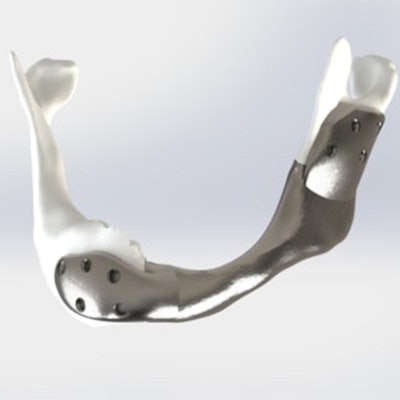
A patient with head and neck cancer received the first 3D-printed titanium lower jaw in a successful operation, according to an August 4 press release from the Netherlands Cancer Institute (NCI). The jaw was reconstructed based on the patient's imaging.
Following four years of research led by head and neck surgeons from the NCI and 3D printing service company Dutch Mobius 3D Technology (M3DT), the new type of 3D-printed mandible was created using magnetic resonance imaging and computed tomography scans.
The new jaw is designed to be the same shape and weight as the original bone and is stronger than the metal plates typically used in jaw replacement surgeries. It also features an improved fastening technique, making the implant much stronger, as the forces are better distributed, according to the NCI.
 The Netherlands Cancer Institute successfully carried out the first operation with a custom 3D-printed titanium lower jaw. Image courtesy of Mobius 3D Technology.
The Netherlands Cancer Institute successfully carried out the first operation with a custom 3D-printed titanium lower jaw. Image courtesy of Mobius 3D Technology.Tumors in and surrounding the lower jaw are commonly treated by removing part of the mandible. If it is possible, the mandible is reconstructed using bone from elsewhere in the patient's body. These reconstructive operations are complex, requiring vascular anastomosis and potentially causing morbidity at the donor site.
Mandible reconstruction using metal plates poses other concerns as well. According to the NCI, in about 40% of cases, the plates extrude through the mucosa or skin and the screws come loose, which have considerable consequences for the patient.
Because the M3DT titanium implant is custom-made, the jaw maintains its fit, and pressure on the mucosa and skin is distributed more evenly. The implant also has fixation screws to help ensure it stays in place, and the mesh structure on the inside allows the new implant to retain its strength while the prosthesis feels light for the patient.
The operation is also much simpler and shorter, since the tools the surgeon uses during the procedure are patient-specific. The implant is expected to be more widely applicable in 2023 or 2024.
"We hope this will diminish complications and improve functional and esthetic outcome," the NCI stated in the release.



















